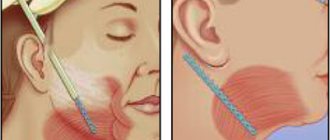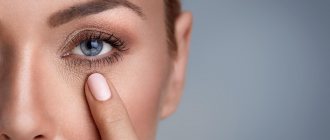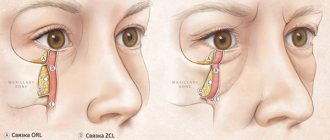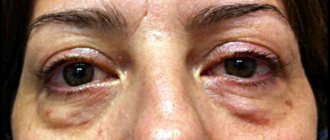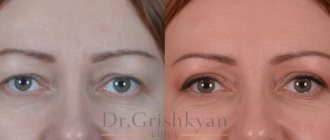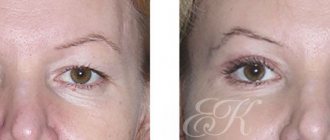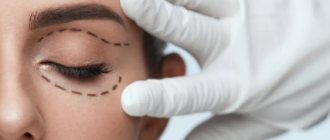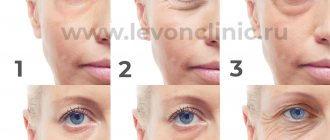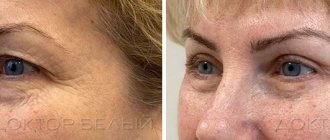If the first thing you see in the mirror in the morning are bags under your eyes, then you need to get rid of them urgently so as not to look constantly tired. Of course, sometimes you just need to start getting enough sleep (due to lack of sleep, many residents of megacities such as Moscow often turn to surgeons to remove circles under their eyes), and then they will go away on their own. But what if this doesn't happen? First, you need to find the cause of their occurrence, this could be genetic characteristics, kidney or liver disease, as well as normal aging.
How and why do lower eyelid hernias form?
First, let's understand the anatomy of the middle zone of the face, and only then we will study the mechanism of aging and the formation of hernias of the lower eyelids.
Please study the picture carefully along with the comments below:
Anatomy of the midface
Immediately behind the skin is the orbicularis oculi muscle (position B), which is responsible for blinking and facial expressions in the periorbital region. The orbicularis muscle is called circular because of its shape:
Orbicularis oculi muscle, facial expressions
The orbicularis oculi muscles are tightly fused to the skin. In people with thin skin of the lower eyelids, dark circles under the eyes are visible - this is nothing more than the translucent orbicularis muscles of the eye.
The orbicularis oculi muscles, together with the skin, are attached to the facial skeleton not over the entire surface, but in some places with the help of ligaments . In the lower eyelid area there are two ligaments: ORL (pos. A) and ZCL (pos. D) . Ligaments are not point elements, but extended ones:
ORL and ZCL ligaments in the midface ©bmendelson.com.au
The attentive reader noticed that the trajectory of the ligaments coincides with the trajectory of the grooves of the lower eyelid:
ORL and ZCL ligaments on the human face ©Dikarev Alexey Sergeevich
Now we have come to understand the mechanism of the appearance of hernias of the lower eyelids and sacs.
With age, four independent processes occur:
- Loss of tone in the orbicularis oculi muscle;
- Decreased skin turgor and elasticity;
- Reducing the volume of fat bags and their redistribution;
- Reduction in the volume of the facial skeleton—bone resorption.
Ligaments behave differently - they do not stretch or weaken over time. Therefore, grooves are formed along the ligaments.
SPRS therapy for the eye area
SPRS therapy is a new word in rejuvenation. Russian technology allows us to rejuvenate our skin from the inside. New skin cells—autofibroblasts—are grown from a small fragment of one’s own skin. They are injected into problem areas.
New skin cells begin to produce hyaluronic acid and collagen fibers, which results in thickening of the skin, smoothing out facial wrinkles, and improving capillary blood circulation. Accordingly, the patient’s skin becomes firm, elastic, its color improves, the number and depth of wrinkles, as well as the severity of age spots, decreases. And the contours of the face become as clear as in their youth.
It should be noted that the medical technology for the use of autologous fibroblasts has another feature - it allows the patient’s skin fibroblasts to be preserved indefinitely. They can be used at any time both to correct age-related changes in the skin, and in case of an unforeseen situation - in case of burns and other injuries that require the immediate use of fibroblasts to restore the integrity of the skin. This preservation of autologous skin fibroblasts represents a kind of “biological insurance system.” For life!
Lower blepharoplasty
You already guessed that the solution to the problem is cutting the ligaments. At the same time, the soft tissues will not sag, the lower eyelid will not turn out - the middle zone is held in place due to other mechanisms.
Technique for performing fat-sparing lower blepharoplasty
Simultaneously with the dissection of the ligaments, the fat packets are redistributed to form a smooth relief of the midface and eliminate the nasolacrimal groove.
Contraindications to the procedure
The non-surgical blepharoplasty procedure is completely safe , however, there are several contraindications that should not be ignored:
- The presence of malignant neoplasms and tumors
- Diabetes mellitus in the acute phase
- Bleeding disorder
- Acute infectious diseases, including infectious skin diseases and chronic inflammation
- Acute diseases of the respiratory system and heart
It is worth refraining from the procedure during periods of lactation and pregnancy, because... Stress can harm a child's health. For more detailed information about contraindications, ask a specialist in hardware cosmetology.
Lower blepharoplasty with fat removal
Some surgeons practice removing orbital fat without cutting the ligaments. This is the wrong tactic: over time, there is less fat on the face, and the facial skeleton appears - this process is called facial skeletonization.
Notice how Geza Morcsani's cheekbone appears:
Facial skeletonization using the example of Geza Morcsani
This is a long-known fact that is ignored for one simple reason - the reluctance to cut the ligaments for fear of damaging the facial nerve, the process of which runs right next to the ORL ligament.
If the facial nerve is damaged, denervation of the orbicularis oculi muscle will occur, leading to muscle atrophy, round eye or ectropion of the lower eyelid. Full restoration of the function of the orbicularis oculi muscle will no longer be possible.
It is very easy to damage nerves if you do not know the anatomy of the face. My experience in the surgical treatment of oncological patients in the head-neck area on the flow, plus hundreds of disassembled cadaver materials, allowed me to thoroughly study the anatomy of the face and its many variations. Therefore, I can confidently perform any facial surgery, including blepharoplasty.
I remove orbital fat only in one case - with Graves' disease - bulging eyes:
Blepharoplasty for Graves' disease (bulging eyes) ©Dikarev Alexey Sergeevich
In this case, there is a lot of orbital fat, so it must be partially removed. Read more about the treatment method for bulging eyes in the article:
Surgical treatment of bulging eyes - Olivari operation
Where in Moscow to remove circles under the eyes?
Dr. Igor Anatolyevich Bely has been successfully practicing plastic surgery for more than 23 years. Every year he performs about a thousand different surgeries to help his patients transform themselves. Doctor Bely will find out and fulfill all your wishes with precision. Sign up for a consultation with surgeon Igor Anatolyevich Bely by leaving a request on the website or by calling5 or write to messengers: or.
Fillers
Knowing the anatomy of the midface and the mechanism of aging, you can now guess how fillers work.
Fillers fill the volume of the middle zone, stretch the soft tissues, temporarily hiding the nasolacrimal groove. But this trick only works with elastic skin and a “strong” orbicularis oculi muscle, i.e. up to a certain age.
I have nothing against fillers, only for them. The main thing is that patients do not think that fillers are an alternative to blepharoplasty. Each method has its own indications and contraindications; do not confuse warm with soft.
Advantages of treatment at the Swiss University Hospital
- The clinic’s equipment with the latest expert-class equipment allows our specialists to carry out operations of any type of complexity.
- Patients can expect comprehensive care from the initial consultation to post-recovery follow-up visits. Laboratory diagnostics for more than 5,000 indicators, any types of instrumental and hardware diagnostics, and appointments with leading specialists in more than 15 areas are available to patients.
- The clinic also performs simultaneous operations: getting rid of 5-6 diseases that require surgical treatment during one anesthesia. Plastic surgeries, removal of hernias, tumors, gastrointestinal pathologies, etc., but one preoperative examination, 1-3 days of hospitalization and a couple of weeks for recovery!
- We have our own resuscitation department and intensive care wards; after the operation, the patient is under round-the-clock monitoring by experienced staff.
- The patient rooms have everything necessary for a comfortable stay; if necessary, an individual post of experienced medical staff is possible.
Here's something else interesting
Ideal nose - how to get rid of a hump?
Surgical treatment of bulging eyes - Olivari operation
How to remove a double chin and tighten your neck?
How to get rid of jowls? Lifting, SMAS-lifting, MACS-lift.
The operation consists of several stages:
- preparation and marking of proposed cuts;
- anesthesia - both local and general anesthesia are possible;
- access - performed according to markings applied to the skin;
- surgical procedures, the scope of which depends on the type of surgical intervention;
- suturing - carried out using cosmetic stitches using modern suture material.
At the end of the surgical intervention, an aseptic bandage is applied to the eyelids for 4-6 hours. The duration of blepharoplasty varies from 30 to 120 minutes. Discharge is possible 2-3 days after the operation.
Features of the rehabilitation period
Compliance with all recommendations during the rehabilitation period by the patient is the key to the success of the procedure. Proper care will not only help reduce discomfort (for example, after grinding), but will also ensure faster healing and renewal of the skin.
Some recommendations that must be followed during the rehabilitation period:
- Avoid wearing makeup or cosmetics in the eye area - it can cause irritation, which in turn will slow down the recovery process.
- Sunglasses are a must because... they provide reliable protection from sunlight (exposure to which is contraindicated during the rehabilitation period). Glasses are the best choice because... After blepharoplasty, it is highly not recommended to use SPF creams for sun protection.
- You can and even need to use restorative agents to quickly get rid of bruises and swelling. In this matter, you should trust your doctor; any amateur activity can not only worsen the results of the procedure, but also cause skin irritation.
- No solariums, baths or saunas - high temperature and humidity will ruin the result of the operation, and swelling will take much longer to go away. The duration of such a ban is again determined by your attending physician.
Your doctor may schedule follow-up appointments to monitor your situation and improve your outcome during the rehabilitation period—never miss these appointments.
How long does the result last after the procedure?
This primarily depends on the type of non-surgical blepharoplasty chosen. For example, laser treatment can provide a more lasting effect than injections.
- On average, after injection therapy, the result lasts for 2-4 years.
- As for hardware cosmetology , it depends on the chosen technique. On average from 5 to 8 years.
We recommend laser blepharoplasty because... At the moment, it outperforms all other methods in terms of the ratio of benefits. The maximum lasting effect, the predicted result, solves most problems with the lower and upper eyelids - the main advantages of laser blepharoplasty.
In conclusion, we suggest watching a video about laser blepharoplasty in our clinic :

